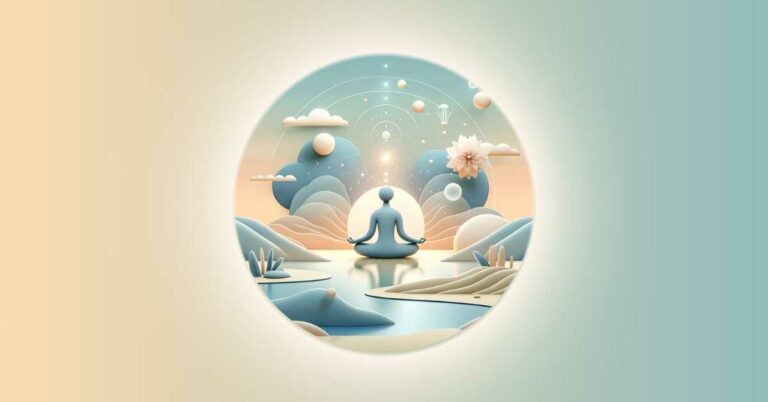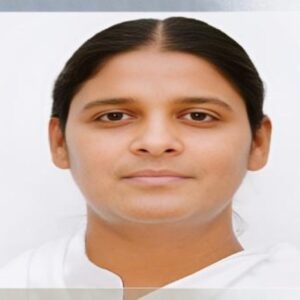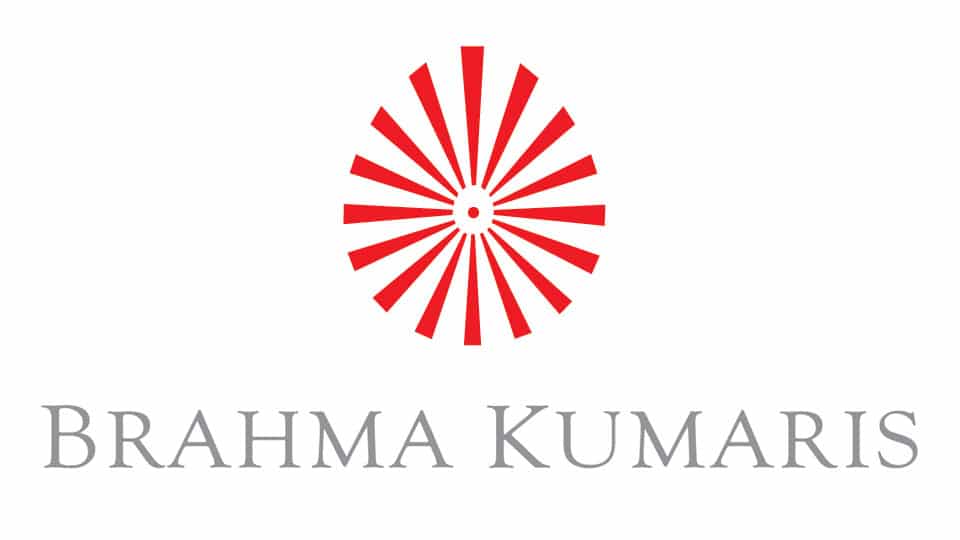Research Objectives:
Understand the transformative potential of Raja Yoga in promoting stress reduction, focus improvement, and a greater sense of purpose.
Keywords:
Raja Yoga, Meditation, Self-transformation, Mindfulness, Soulfulness, Digital Technology
Bio
Dr B K Geeta Didi, Guinness world record holder for bringing positive change is a true embodiment of spiritual wisdom, has devoted over 35 years of her life to the Brahma Kumaris organisation, tirelessly working towards personal and global transformation. With fervor and passion, she imparts knowledge and nurtures the growth of individuals through spiritual, moral, and value education. Her teachings and guidance have left a profound impact on countless lives, helping individuals find inner peace, clarity, and purpose. Dr B K Geeta Didi’s deep understanding of spirituality and her ability to communicate complex concepts in a relatable manner make her a revered mentor. Through her unwavering dedication, she continues to inspire and uplift others on their spiritual journeys.
Abstract
In a world increasingly dominated by digital technology, Raja Yoga meditation emerges as a powerful tool for fostering global well-being. This paper delves into the empowering influence and self-transformative power of this ancient practice. Raja Yoga, with its emphasis on self-awareness and inner peace, equips individuals with the mental and emotional resilience necessary to navigate the myriad challenges of the digital age. The paper highlights the transformative potential of Raja Yoga in several key areas: stress reduction, focus improvement, and fostering a greater sense of purpose. These benefits are particularly pertinent in today’s fast-paced, digitally-driven society, where the constant bombardment of information can lead to heightened stress and a sense of disconnection. Furthermore, the paper discusses the innovative ways in which Raja Yoga is embracing technology to enhance its accessibility and personalise the meditation experience. Through apps, online classes, and virtual communities, practitioners can now engage with Raja Yoga in ways that ft seamlessly into their daily lives. This integration of traditional meditation techniques with modern technology not only makes Raja Yoga more accessible to a global audience but also ensures that the practice evolves to meet the needs of contemporary society. By merging the timeless wisdom of Raja Yoga with the advancements of the digital era, this practice is uniquely positioned to promote holistic well-being in the digitised world, offering a pathway to inner peace and resilience amidst the chaos of modern life.
Introduction
The ever-expanding digital landscape, while offering countless benefits, can also be a source of stress, anxiety, and a sense of disconnection (Teepe, Glase, & Reips, 2023). In this hyper-connected world, the ancient practice of Raja Yoga meditation offers a powerful counterpoint (Nagesh, Revitalizing Modern Minds: Embracing Brahma Kamari’s Raja Yoga Meditation for Modern Challenges, 2023). More than just a relaxation technique, Raja Yoga is a transformative journey that fosters inner peace, self-awareness, and a deeper connection to oneself. There is an empowering influence and self-transformative power of Raja Yoga meditation, with the potential to cultivate global well-being in the digital age (Nagesh, Brahma kumaris raja yoga meditation in modern times: Addressing the current issues and applications, 2023). Figure 1 illustrates the Yoga philosophy, which outlines four paths leading to enlightenment.
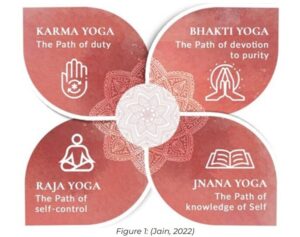
Aim:
This study aims to examine how Raja Yoga equips individuals with the tools to navigate the complexities of the digital world, fostering stress reduction, improved focus, and a renewed sense of purpose. Furthermore, we will explore the innovative ways in which Raja Yoga is embracing technology to enhance accessibility and personalise the meditation experience.
Method
Via an extensive review of literature and personal experiences, this study explores Raja Yoga’s role in promoting holistic well-being in a digitised world. The research methodology involves a comprehensive analysis of existing scholarly articles, books, and credible online resources to understand the theoretical foundations and documented benefits of Raja Yoga. Additionally, personal anecdotes and qualitative data from practitioners were gathered to provide a practical perspective on the practice’s impact. This dual approach ensures a robust examination of both the empirical and experiential dimensions of Raja Yoga, highlighting its potential to enhance mental and emotional resilience, reduce stress, and improve focus. By integrating these diverse sources of information, the study aims to present a well-rounded view of how Raja Yoga can be effectively utilised to foster well-being in an increasingly digital society.
Results and Discussion
3.1 The Digital Age and its Impact on Well-being:
The digital age has undeniably revolutionised our lives. From instant communication across continents to information at our fingertips, technology offers unparalleled convenience and connectivity (Somani, 2021). However, this constant barrage of stimuli and the ever-present digital world come with a hidden cost – a potential detriment to our well-being.
While social media platforms connect us with loved ones and provide a platform for self-expression, they can also fuel feelings of inadequacy and social comparison (Qiu, 2024). The curated online personas we see can distort reality, leading to anxiety and low self-esteem. Additionally, the pressure to stay constantly connected can disrupt sleep patterns and contribute to a sense of information overload.
Despite these challenges, technology also offers potential solutions. Mindfulness apps and online meditation resources are becoming increasingly popular tools for managing stress and improving focus. Ultimately, the impact of the digital age on well-being depends on how we choose to interact with it (Büchi, 2024). By setting boundaries, fostering digital literacy, and embracing practices that promote mental well-being, we can harness the power of technology while safeguarding our emotional and mental health.
Digital age can affect well-being in the following ways:
Information Overload: The constant influx of information, news updates, and social media notifications can be overwhelming. This can lead to feelings of anxiety, difficulty concentrating, and decision fatigue.
Social Media Pressures: The curated perfection often portrayed on social media platforms can breed feelings of inadequacy, envy, and loneliness. The pressure to maintain an online presence can also contribute to stress and anxiety.
Attention Fragmentation: The constant availability of digital distractions disrupts our ability to focus for extended periods. This can negatively impact productivity, creativity, and the ability to engage deeply in tasks or relationships.
Sleep Disruption: The blue light emitted by electronic devices suppresses the production of melatonin, a hormone crucial for sleep regulation. This can lead to sleep disturbances, further impacting our overall well-being.
Social media, while fostering connection, can also be a breeding ground for negativity (Osborne, Costello, & Duckitt, 2023). The curated portrayal of others’ lives can lead to social comparison and feelings of inadequacy. Additionally, the pressure to maintain an online presence and the fear of missing out (FOMO) can further exacerbate anxiety and loneliness.
Furthermore, the digital world can be addictive. The constant notifications and dopamine hits we receive from social media and online games can disrupt sleep patterns and decrease attention spans. This can lead to a vicious cycle, where a lack of sleep further diminishes our ability to focus, making us crave the stimulation of digital devices even more.
3.2 Raja Yoga: A Pathway to Inner Peace:
In today’s fast-paced, technology-driven world, it’s easy to feel overwhelmed and disconnected from ourselves. The constant barrage of information and social media pressure can leave us feeling stressed, anxious, and yearning for a sense of inner peace. It’s in these moments that ancient practices like Raja Yoga meditation, offered by the Brahma Kumaris, emerge as a powerful tool for self-discovery and well-being.
The Brahma Kumaris, a global socio-spiritual organisation, promotes Raja Yoga as a path to self-realisation and spiritual connection (BK, Meditation, 2023). Unlike some meditation practices, Raja Yoga doesn’t require specific mantras or rituals. Instead, it focuses on cultivating self-awareness and inner peace through simple techniques. Here’s how Raja Yoga, as taught by the Brahma Kumaris, can be your gateway to inner tranquility:
Inner Refection: Raja Yoga meditation encourages us to turn our attention inwards. By focusing on the breath and observing our thoughts and emotions without judgment, we gain a deeper understanding of ourselves. This self-awareness is the first step towards managing stress and fostering emotional resilience.
Taming the Mind: Our minds are often bombarded with a constant stream of thoughts. Raja Yoga techniques, like focusing on a point of light or a spiritual image, help us train our attention and reduce mental chatter. This newfound mental discipline allows us to approach challenges with a calmer and more focused perspective.
Connecting with the Divine: The Brahma Kumaris emphasise the importance of connecting with our inner spiritual essence. Through Raja Yoga meditation, we cultivate a sense of peace and connection with a higher power, a source of strength and comfort in difficult times.
The beauty of Raja Yoga with the Brahma Kumaris is its accessibility. Their meditation sessions are open to all, regardless of age, background, or religious beliefs. They offer guided meditations, educational workshops, and online resources to make learning Raja Yoga convenient and easy to integrate into your daily life (Kumaris, 2024).
Raja Yoga, meaning “the royal path,” is an ancient practice that emphasises self-awareness and inner peace. The Brahma Kumaris teach a simple and accessible form of Raja Yoga meditation, focusing on withdrawing the attention from external stimuli and directing it inwards. Through meditation, we can cultivate a space of inner silence, a sanctuary from the digital chaos.
Reduced Stress and Anxiety: By focusing on the breath and cultivating inner stillness, meditation helps calm the mind and reduce stress hormones. This can lead to a sense of relaxation and emotional balance.
Enhanced Focus and Concentration: Meditation trains the mind to become more focused and less prone to distractions. This can improve our ability to concentrate on tasks in the digital world and beyond.
Increased Self-Awareness: Through meditation, we gain a deeper understanding of our thoughts, emotions, and reactions. This self-awareness empowers us to make conscious choices and respond to situations rather than simply react.
A Meditation for Everyone: Raja Yoga meditation with the Brahma Kumaris is open to people of all ages, backgrounds, and faiths. It requires no special equipment or rituals, making it easily accessible in the comfort of your own home. The Brahma Kumaris offer free meditation classes and resources online and in person, making it easier than ever to embark on your journey to inner peace.
In conclusion, Raja Yoga meditation with the Brahma Kumaris offers a powerful antidote to the challenges of the digital world. By cultivating inner peace, focus, and self-awareness, we can navigate the digital landscape with greater resilience and well-being. So, take a moment, close your eyes, and embark on your own journey to inner peace with Raja Yoga meditation.
3.3 Stress Reduction through Raja Yoga:
Chronic stress has become a defining characteristic of the modern world. Our fast-paced lives, bombarded by information and constant connectivity, leave us feeling perpetually on edge. Fortunately, ancient practices like Raja Yoga meditation offer a powerful tool for stress reduction, providing a much-needed oasis of calm in the digital storm.
Raja Yoga, meaning “royal union,” emphasises self-awareness and inner peace. One of its key benefits is its ability to combat stress. Here’s how:
Physiological Relaxation: Raja Yoga incorporates breathwork techniques like Pranayama. Focusing on the breath regulates the nervous system, lowering cortisol (the stress hormone) levels. This physiological shift promotes a sense of calm and reduces physical tension associated with stress.
Quieting the Mind: Stress often manifests as a constant mental chatter. Raja Yoga teaches us to observe our thoughts without judgment, creating a space between ourselves and our thoughts. This allows us to detach from negative thought patterns and anxieties, fostering mental tranquility.
Focus and Mindfulness: Raja Yoga meditation strengthens our ability to focus on the present moment. This reduces rumination on past worries and anxieties about the future, two major contributors to stress. By anchoring ourselves in the present, we learn to respond to situations calmly and thoughtfully, rather than reacting impulsively under stress.
Inner Peace and Resilience: Through regular practice, Raja Yoga cultivates a sense of inner peace and emotional resilience. This newfound mental strength allows us to better manage stressful situations and bounce back from challenges with greater ease.
The beauty of Raja Yoga for stress reduction lies in its cumulative effect. Regular practice cultivates a sense of inner calm that spills over into our daily lives. We become less reactive to external stressors and more equipped to navigate the complexities of the digital age with greater balance and composure.
Raja Yoga, meaning “royal union,” focuses on harnessing the mind’s power to achieve inner harmony. This practice equips us with techniques that directly target the physiological and psychological effects of stress. Here’s how Raja Yoga meditation helps to unwind the digital knot:
Physiological Relaxation: Stress triggers the release of cortisol, a hormone that puts our bodies into “fight-or-flight” mode. Raja Yoga incorporates deep breathing exercises that activate the parasympathetic nervous system, promoting relaxation and lowering cortisol levels. This physiological shift reduces muscle tension, slows heart rate, and eases anxiety.
Taming the Thought Storm: The constant mental chatter characteristic of a stressed mind can be overwhelming. Raja Yoga meditation teaches us to observe our thoughts without judgment. By becoming aware of our thought patterns, we can break free from their negative infuence and cultivate a sense of calm amidst the mental storm.
Detachment from External Stimuli: Our digital world bombards us with information and notifcations, keeping our minds constantly engaged. Raja Yoga meditation teaches us to withdraw our attention from external stimuli and focus inwards. This allows us to disconnect from the constant mental chatter and reconnect with our inner peace.
Building Resilience: Chronic stress can leave us feeling overwhelmed and vulnerable. Raja Yoga meditation strengthens our mental and emotional resilience. By regularly practicing mindfulness and self-awareness, we develop the capacity to respond to stressful situations with calmness and composure rather than reacting impulsively.
3.4 Cultivating Emotional Resilience:
The digital age throws a lot at us. From the constant barrage of news to the curated perfection of social media, it’s easy to feel overwhelmed and emotionally drained. This is where emotional resilience comes in the ability to bounce back from setbacks, navigate challenging emotions, and maintain a sense of well-being even in the face of adversity. Fortunately, ancient practices like Raja Yoga meditation offer powerful tools to cultivate this vital skill.
Raja Yoga, meaning “royal union,” emphasises self-awareness and inner peace. By focusing inward, we gain a deeper understanding of our emotions and how they influence our thoughts and actions. Here’s how Raja Yoga helps build a stronger emotional core:
Understanding Your Triggers: Through meditation, we learn to observe our reactions to situations and identify the emotions that Unise our triggers – the events or circumstances that typically throw us off balance. By knowing our triggers, we can anticipate them and develop healthier coping mechanisms.
Acceptance, Not Judgment: Often, our emotional reactions are fueled by resistance to what is happening. Raja Yoga teaches acceptance, not judgment, of our emotions. By acknowledging our feelings without negativity, we detach from them and regain control. This allows us to respond calmly rather than react impulsively.
Developing Detachment: The digital world can fuel a constant need for external validation. Raja Yoga promotes inner strength and a sense of self-worth independent of external circumstances. This detachment allows us to be less affected by negativity online or setbacks in life.
Building a Positive Mindset: Raja Yoga meditation cultivates a sense of optimism and hope. By focusing on the present moment and appreciating the good things in life, we train our minds to see the positive even in challenging situations. This positive outlook fosters resilience and helps us navigate diffculties with a sense of perspective.
Emotional resilience is not about becoming emotionless. It’s about acknowledging, accepting, and managing our emotions effectively. Raja Yoga meditation equips us with the tools to do just that. By strengthening our emotional core, we become better equipped to handle the inevitable ups and downs of life, navigate the digital world with greater ease, and ultimately, thrive in the face of adversity.
Raja Yoga equips us with several tools to build inner strength:
Emotional Regulation: Through meditation techniques like breathwork and visualisation, we learn to regulate our emotional responses. Instead of being swept away by negative emotions, we can observe them objectively and choose a more positive and constructive response.
Acceptance and Non-judgment: Life throws curveballs, and negative emotions are a natural part of the human experience. Raja Yoga teaches us to accept these emotions without judgment. By not resisting them, we allow them to fow through us and eventually dissipate.
Inner Peace as a Foundation: Regular meditation practice cultivates a sense of inner peace that serves as a foundation for emotional resilience. When we feel grounded and centered, we are better equipped to handle the inevitable ups and downs of life.
Developing Detachment: The digital world often fuels feelings of attachment to possessions, social validation, and certain outcomes. Raja Yoga encourages us to cultivate a sense of detachment. This doesn’t mean indifference, but rather a healthy distance from external circumstances, allowing us to maintain emotional stability.
Building Self-Compassion: Raja Yoga fosters self-compassion, the ability to treat ourselves with kindness and understanding. This is crucial for emotional resilience. When we are compassionate towards ourselves, we are less likely to be consumed by self-criticism and negativity, which can exacerbate emotional distress.
Cultivating emotional resilience through Raja Yoga is an ongoing process. However, with consistent practice, we can develop the inner strength and emotional intelligence to navigate the challenges of the modern world with greater ease. Raja Yoga empowers us to not just survive in the digital age, but to thrive, fostering a sense of well-being that allows us to fully embrace life’s experiences, both positive and negative.
Here’s how Raja Yoga meditation fosters emotional resilience:
Understanding Your Emotions: Raja Yoga teaches us to observe our emotions without judgment. This allows us to understand their root causes and identify healthy ways to express or manage them. By acknowledging our emotions instead of suppressing them, we gain greater control over our reactions.
Acceptance and Detachment: Life throws curveballs. Raja Yoga meditation helps us cultivate acceptance of what we cannot control. By letting go of negativity and focusing on the present moment, we lessen the emotional impact of challenges. Building Inner Strength: Through regular meditation practice, we develop mental discipline. This allows us to manage diffcult emotions and resist negative impulses. We become less reactive and more proactive in handling stressful situations.
Finding Inner Peace: At its core, Raja Yoga aims to cultivate inner peace. This sense of calm becomes a foundation for emotional resilience. When faced with challenges, we can draw upon this inner peace to maintain composure and navigate them more effectively.
Raja Yoga meditation isn’t a magic bullet, but it’s a powerful tool. Consistent practice equips us with the skills to manage our emotions effectively. In a world that often bombards us with negativity, Raja Yoga offers a path to inner strength and emotional well-being, empowering us to thrive in the face of adversity.
3.5 Meditation Meets Modernity:
The digital age reigns supreme, offering instant connection and a wealth of information at our fingertips. However, this constant connectivity comes with a hidden cost a rise in stress, anxiety, and a yearning for inner peace. Here’s where a timeless practice, Raja Yoga meditation, steps in, surprisingly finding fertile ground in the digital sphere.
Traditionally, Raja Yoga focused on self-discovery and inner peace through guided instruction and introspection. Today, however, technology is revolutionising its accessibility and reach. Here’s how Raja Yoga is embracing the digital world:
Mobile Meditation Apps: Numerous apps offer guided Raja Yoga meditations tailored for different needs and experience levels. These apps provide a convenient and portable way to integrate meditation into daily life, even amidst busy schedules.
Online Courses and Tutorials: The internet provides a vast library of online courses and tutorials on Raja Yoga meditation. This allows individuals to learn at their own pace and explore different meditation techniques from the comfort of their homes.
Virtual Communities: Online communities dedicated to Raja Yoga meditation offer a space for connection and support. These online groups foster a sense of belonging and allow individuals to share experiences, ask questions, and stay motivated in their practice.
Interactive Meditation Tools: Technology is also paving the way for interactive meditation tools. Biofeedback devices, for instance, can provide real-time feedback on physiological responses during meditation, helping users refne their practice and achieve deeper states of relaxation.This digital embrace of Raja Yoga offers several advantages:
Increased Accessibility: Technology removes geographical barriers, making Raja Yoga meditation accessible to a wider audience than ever before. Anyone with an internet connection can now learn and practice this ancient technique.
Personalised Experience: Digital tools allow for personalised meditation experiences. Apps and online courses can cater to individual preferences and learning styles, making the practice more engaging and effective.
Community Building: Online communities foster a sense of connection and belonging among practitioners, providing valuable support and motivation for continued practice. However, it’s important to acknowledge the potential downsides:
Tech Overload: While technology can enhance accessibility, relying solely on digital tools can defeat the purpose. It’s crucial to maintain a balance between digital meditation and traditional practices.
Distraction: The digital world itself can be a source of distraction. Practicing meditation in a quiet, distraction-free environment remains essential to reap its full benefts.
In conclusion, Raja Yoga’s embrace of the digital sphere opens doors to a wider audience seeking inner peace in a world brimming with digital stimuli. Technology offers convenient tools and fosters a sense of community, but it’s vital to maintain a balance with traditional practices and prioritise a distraction-free environment. By harnessing the power of technology responsibly, Raja Yoga meditation can continue to empower individuals to cultivate inner peace and navigate the complexities of the digital age with greater clarity and well-being.,
By embracing technology, Raja Yoga is no longer confned to meditation centers or yoga studios. It’s transforming into a dynamic and accessible practice that can be integrated into our digital lives. This integration empowers individuals to cultivate inner peace, manage stress, and enhance well-being, fostering a sense of calm amidst the constant digital buzz.
Conclusion
For centuries, Raja Yoga meditation has been touted for its ability to promote inner peace and well-being. However, in recent years, science has begun to catch up with tradition, validating the positive effects of this ancient practice. Let’s delve into the scientific evidence supporting Raja Yoga’s benefits:
Stress Reduction: Numerous studies have shown that Raja Yoga meditation effectively reduces stress hormones like cortisol. By activating the parasympathetic nervous system, Raja Yoga promotes relaxation and counteracts the body’s flight-or-fight response.
Improved Focus and Attention: Brain imaging studies reveal that Raja Yoga meditation enhances activity in areas associated with focus and attention. Regular practice strengthens our ability to flter out distractions and maintain concentration in a world filled with stimuli.
Emotional Regulation: Research suggests that Raja Yoga meditation leads to increased activity in the prefrontal cortex, a region crucial for emotional regulation. This translates to a better ability to manage emotions and respond to challenges with composure.
Enhanced Sleep Quality: Studies have shown that Raja Yoga meditation can improve sleep quality. By reducing stress and promoting relaxation, it allows individuals to fall asleep faster and experience deeper, more restorative sleep.
Cognitive Benefits: Emerging research points towards potential cognitive benefits associated with Raja Yoga meditation. Studies suggest it may improve memory, cognitive flexibility, and overall cognitive function.
It’s important to note that research on Raja Yoga is ongoing, and further studies are needed to fully understand the mechanisms behind its benefits. However, the growing body of scientific evidence strengthens the case for Raja Yoga as a valuable tool for promoting mental and emotional well-being.
Beyond the studies mentioned above, Raja Yoga’s benefits are often described in terms of:
Increased Self-Awareness: Through meditation, individuals gain a deeper understanding of their thoughts, emotions, and behavioral patterns. This self-awareness empowers them to make conscious choices and cultivate positive change.
Greater Sense of Well-being: Raja Yoga fosters a sense of inner peace and well-being that transcends temporary emotional states. This holistic approach to well-being enhances overall quality of life. Science is backing the benefits of Raja Yoga through the following:
Stress Reduction: Studies have shown that Raja Yoga meditation practices like mindful breathing and focused attention effectively activate the parasympathetic nervous system, promoting relaxation and reducing stress lates to lowered blood pressure, decreased anxiety, and improved sleep quality.
Enhanced Focus and Cognition: Research suggests that Raja Yoga meditation can improve cognitive function. Studies have shown positive effects on working memory, attention span, and executive function the mental skills that govern decision-making and planning.
Emotional Regulation: Raja Yoga’s emphasis on self-awareness equips individuals to identify and manage emotions effectively. Brain imaging studies show that meditation practices can strengthen areas associated with emotional regulation, leading to greater resilience and a decrease in reactivity.
Improved Physical Health: The stress-reduction benefits of Raja Yoga can positively impact physical health. Studies have linked meditation practices to lower blood pressure, improved immune function, and reduced pain perception.
While research is ongoing, the growing body of evidence is promising. Raja Yoga meditation appears to be more than just a feel-good practice; it offers tangible benefits for both mental and physical well-being.
Here are some key considerations when evaluating scientific research on Raja Yoga:
Standardization of Practices: Raja Yoga encompasses various techniques. Studies need to clearly define the specific practices used to ensure generalizability of findings.
Control Groups: Strong research designs involve comparison groups that don’t participate in meditation. This helps isolate the effects of Raja Yoga from other factors influencing well-being.
Long-Term Effects: Many studies focus on short-term benefits. Further research is needed to explore the long-term impact of consistent Raja Yoga practice.
The scientific exploration of Raja Yoga is in its early stages, but the initial findings are encouraging. As research continues, we can expect a deeper understanding of the mechanisms by which this ancient practice promotes well-being in the modern world. This growing body of evidence reinforces the value of Raja Yoga as a powerful tool for navigating the complexities of the digital age and fostering holistic well-being.
Integration with Healthcare: The growing scientific evidence supporting the benefits of Raja Yoga might pave the way for its integration with mainstream healthcare. Imagine meditation apps being prescribed by doctors or Raja Yoga becoming a standard practice in stress management programs.
4.1 The Future of Raja Yoga in a Digital World
The digital age presents both challenges and opportunities for ancient practices like Raja Yoga meditation. As technology continues to evolve, so too will Raja Yoga, adapting and integrating with the digital sphere to reach a wider audience and offer even greater benefits. Figure 2 provides a glimpse into the potential future of Raja Yoga:
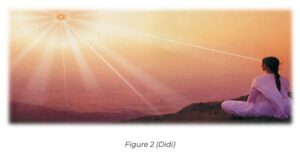
AI-Powered Personalization: Artificial intelligence (AI) has the potential to personalize the Raja Yoga experience further. Imagine AI-powered apps that analyse your emotional state and tailor meditation practices to address specific needs in real-time.
Virtual Reality (VR) Immersion: VR technology can create immersive meditation environments, transporting users to serene landscapes or calming virtual temples. This could enhance focus and mindfulness during meditation practice.
Biofeedback Integration and Gamification: Advanced biofeedback technologies could provide even more detailed feedback on physiological responses during meditation. Gamification techniques could be incorporated to create engaging and motivating meditation experiences.
Global Community Building: Digital platforms can facilitate the creation of even more vibrant online Raja Yoga communities. These communities can foster a sense of global connection and shared purpose, promoting peace and well-being across borders.
Scientific Validation and Integration: The future holds promise for further research into the benefits of Raja Yoga. As scientific evidence grows, it could lead to the integration of Raja Yoga practices into mainstream healthcare and stress management programs.
The future of Raja Yoga in the digital world is not about replacing traditional practices, but rather, about enhancing them. Technology can provide new tools and experiences that make Raja Yoga more accessible, engaging, and effective. This symbiotic relationship between ancient wisdom and modern technology has the potential to empower individuals around the globe to cultivate inner peace, emotional resilience, and a sense of well-being in the ever-evolving digital landscape.
References
BK. (2023). Meditation. Retrieved from Brahma Kumaris: https://www.brahmakumaris. org/
BK. (2024). Brahma Kumaris. Retrieved from Brahma Kumaris:https://www.brahmakumaris.com/
Büchi, M. (2024). Digital well-being theory and research. New Media & Society, 172-189.
Didi, D. B. (n.d.). Future of Raja Yoga. Brahma Kumaris.
Jain, R. (2022, 06 06). What Is Raja Yoga? The Yoga of Self-Control Demystifed. Retrieved from Arhanta Yoga: https://www.arhantayoga.org/ blog/raja-yoga/
Kumaris, P. B. (2024). Understanding Consciousness. Rajasthan: Brahma Kumaris Retrieved from https://www. brahmakumaris.com/bkuc.
Nagesh, N. V. (2023). Brahma kumaris raja yoga meditation in modern times: Addressing the current issues and applications. Journal of Emmerg ing Technologies and Innovative Research, 65-77.
Nagesh, N. V. (2023). Revitalizing Modern Minds: Embracing Brahma Kamari’s Raja Yoga Meditation for Modern Challenges. Journal of Emerginf Technologies and Innovative Research , 714-736.
Nagesh, N. V. (2023). The Transformative Power of Brahma Kumaris Raja Yoga Meditation: Emerging Trends and Future Perspectives. International Journal of Innovative Science and Research Technology , 554-563.
Osborne, D., Costello, T., & Duckitt, J. e. (2023). The psychological causes and societal consequences of authoritarianism. Nat Rev Psychol, 220– 232.
Qiu, Y. (2024). Social Comparison on Social Media Platforms: A media and communication Perspective. SHS Web of Conferences.
Somani, P. (2021). Information Technology Challenges Faced during the Covid-19 Pandemic in Higher Education. . International Journal of Latest Research in Engineering and Technology.
Teepe, G. W., Glase, E. M., & Reips, U. D. (2023). Increasing digitalization is associated with anxiety and depression: A Google Ngram analysis. PLoS One.

